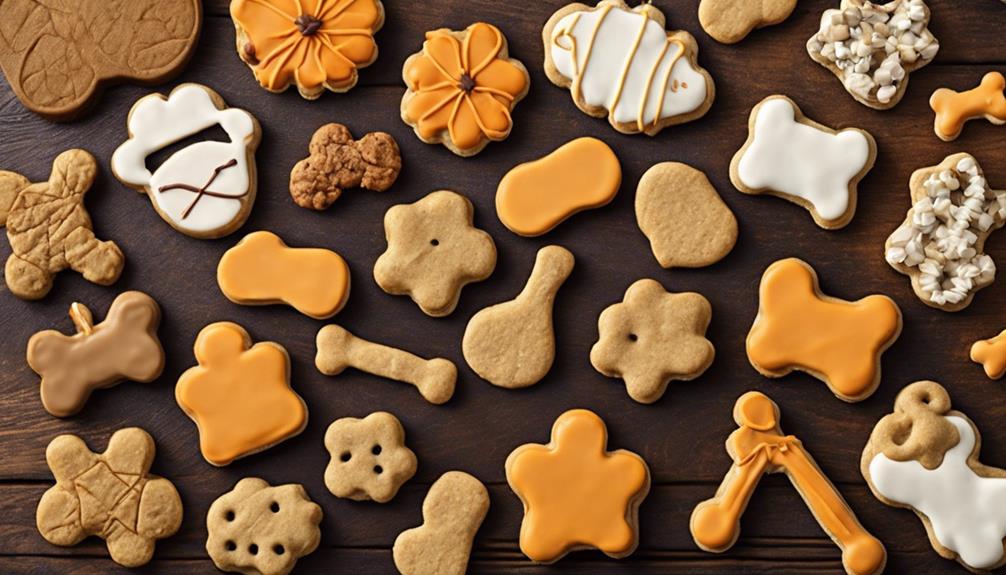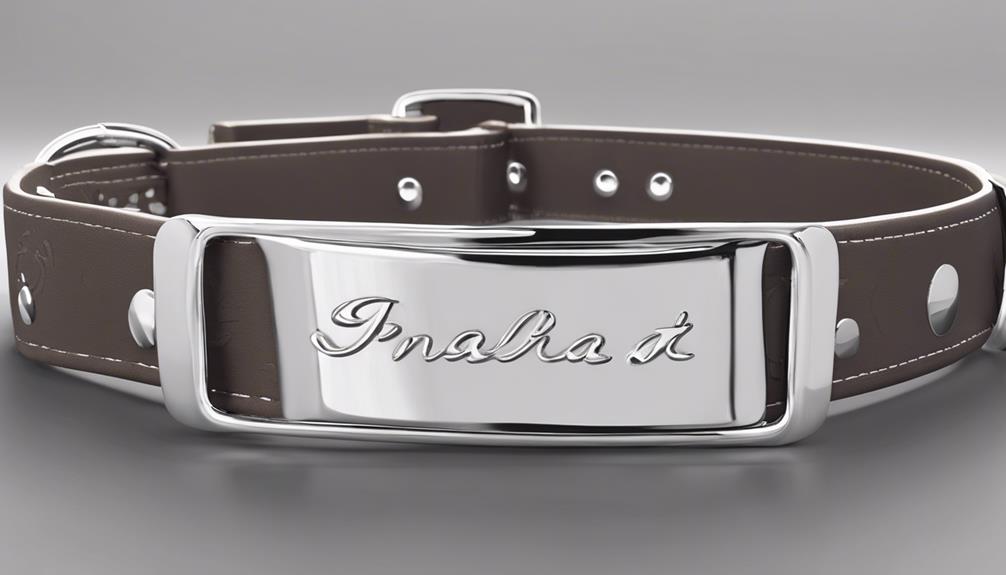To make healthy dog training treats, you will need canned pumpkin, peanut butter, flour, and eggs as the main components. Combine these ingredients to form a dough that can be easily shaped. Opt for small, soft treats that are low in calories for easy consumption during training sessions. Bake at 350°F for approximately 25 minutes, then allow them to cool. Store any extras in the refrigerator to maintain freshness. Keep in mind that choosing the right treats can improve your dog’s training and overall health.
Key Takeaways
- Opt for small, soft treats low in calories for quick training rewards.
- Customize homemade treats with high-quality, dog-friendly ingredients.
- Ensure treats are easily consumed and have a soft texture for chewing.
- Use natural, nutrient-rich ingredients like pumpkin and peanut butter.
- Store treats properly in airtight containers in the fridge or freezer for freshness.
Ingredients for Homemade Dog Treats
When preparing homemade dog treats, gather the necessary ingredients like canned pumpkin, peanut butter, flour, and eggs. These components serve as the foundation for many dog treat recipes and offer a wholesome and nutritious snack for your furry companion. Canned pumpkin is a popular element in dog treats, as it's high in fiber and aids in digestion. Peanut butter adds taste and healthy fats that dogs enjoy. Flour helps unite the ingredients together, creating a dough-like texture. Eggs function as a natural binder and supply extra protein for your dog's diet.
For training treats, it's crucial to take into account the size, texture, and calorie content. Training treats are usually smaller in size to be readily consumed during training sessions. They've a softer consistency for easy chewing and are lower in calories to prevent excessive feeding. By preparing homemade treats, you can customize the ingredients to your dog's requirements and preferences, ensuring they receive a nutritious and tasty reward during training sessions.
Step-by-Step Treat Making Instructions

When making homemade dog training treats, the key aspects to focus on are ingredient selection tips and baking process details. By selecting the right ingredients and following the baking instructions carefully, you can guarantee that your treats turn out delicious and perfectly suited for training purposes.
Paying attention to these key aspects will help you create treats that your furry friend will love and respond to during training sessions.
Ingredient Selection Tips
For selecting the best ingredients for your homemade dog treats, focus on high-quality, dog-friendly options like canned pumpkin, peanut butter, and flour.
When choosing ingredients for your training treats for dogs, consider these tips:
- Opt for natural ingredients to guarantee healthy dog training.
- Avoid harmful foods like chocolate, corn on the cob, and artificial sweeteners.
- Mix pumpkin, peanut butter, egg, and optional extras for flavor.
- Adjust batter consistency with water or broth and use silicone molds for easy shaping.
Baking Process Details
To bake your homemade dog training treats, start by preheating the oven to 350℉.
Mix ingredients like pumpkin, peanut butter, and flour to create a batter. Adjust the consistency with water or broth before placing the mixture into silicone molds. Confirm the molds are filled evenly.
Bake the treats for about 25 minutes until they're cooked through. You can check for doneness by inserting a toothpick – if it comes out clean, they're ready.
Once baked, remove the treats from the molds and allow them to cool before serving them to your furry friend.
Store any leftovers in the fridge to keep them fresh for longer training sessions.
Nutritional Benefits of Dog Treats
Homemade dog training treats offer a nutritious boost to your canine companion's diet. When considering the nutritional benefits of these treats, keep in mind the following points:
- Nutrient-Rich: Homemade treats can be packed with essential nutrients crucial for your dog's health and well-being.
- Calorie-Controlled: These treats are often lower in calories compared to commercial options, making them ideal for frequent use during training without worrying about excessive weight gain.
- Quality Ingredients: By using high-quality ingredients such as pumpkin, peanut butter, and whole wheat flour, you can guarantee that your dog gets the best in terms of taste and nutrition.
- Ingredient Control: Making your own treats allows you to have full control over what goes into them, ensuring they're free from harmful additives or preservatives.
Dos and Donts of Treat Making
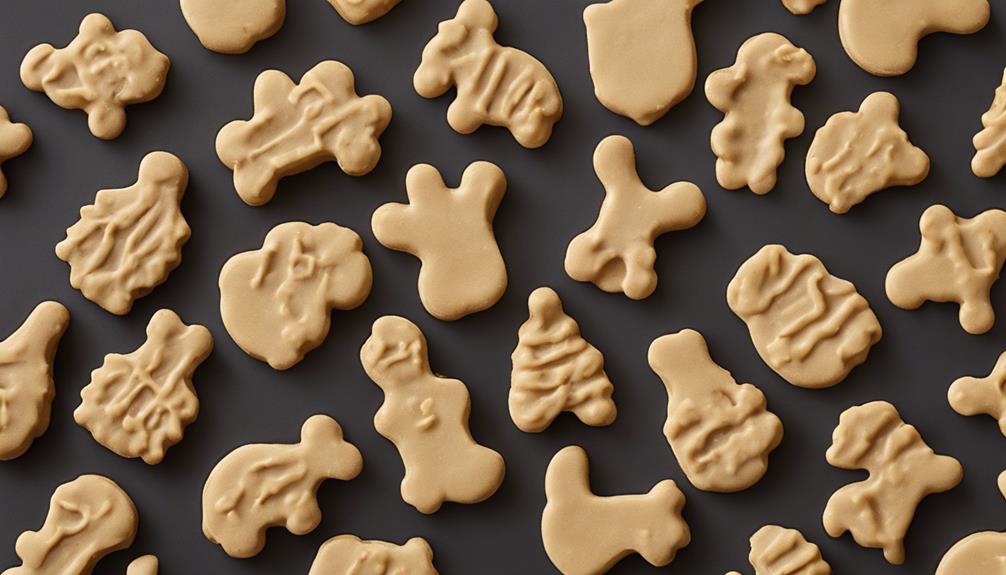
Make sure your homemade dog treats are crafted with safe ingredients and meet the right size, texture, and taste requirements for effective training. When creating dog treats, choose ingredients like pumpkin, peanut butter, and flour to guarantee your furry friend's safety. Keep in mind, the size of the treat should be small enough for quick consumption during training sessions. Additionally, the texture should be firm yet easy to chew, and the taste should be enticing for your dog's motivation.
Avoid toxic foods such as chocolate, grapes, and cooked bones in your dog treat recipes. These ingredients can be harmful to your pet's health and should be completely avoided. Always prioritize using safe and dog-friendly ingredients to prevent any adverse reactions.
Lastly, store homemade treats properly in the fridge or freezer to maintain their freshness. Proper storage will ensure that your treats remain safe for consumption and effective for training purposes. By following these dos and don'ts of treat making, you can create healthy, delicious, and safe treats for your beloved canine companion.
Storage Tips for Fresh Treats
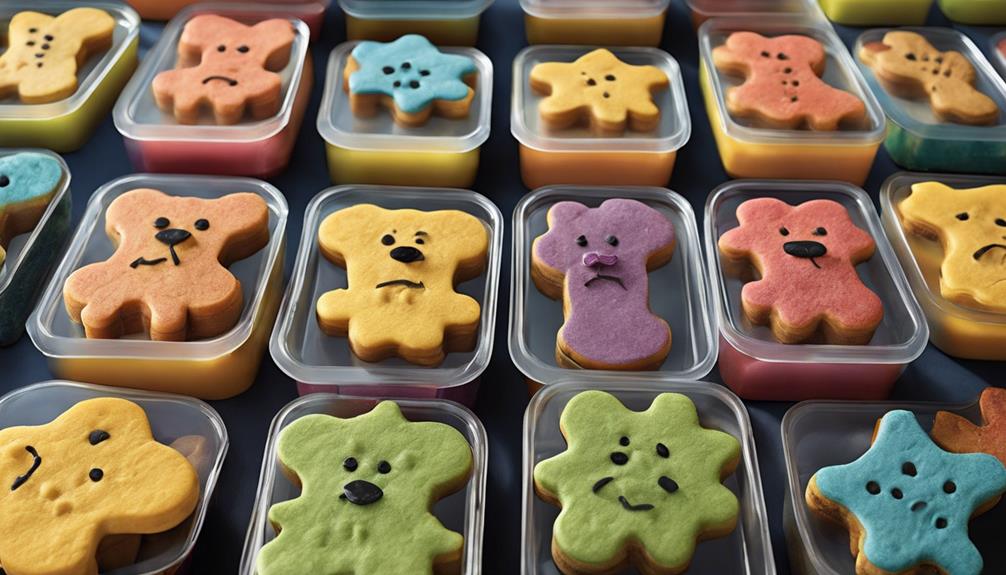
To ensure your homemade dog treats stay fresh, it's crucial to store them in an airtight container in the refrigerator. This helps preserve their quality and prevents spoilage.
If you wish to prolong the treats' shelf life, consider freezing them for up to 3 months.
Proper Treat Container
Consider using a sturdy airtight container to store your fresh homemade dog treats in the refrigerator to maintain their freshness and quality.
Here are some tips for proper treat container storage:
- Airtight Containers: Seal in the freshness to prevent spoilage.
- Refrigeration: Keep treats in the fridge for up to a week for best freshness.
- Freezing Option: Freeze treats for longer storage, up to 3 months.
- Maintain Quality: Proper storage helps retain taste and texture for rewarding training sessions.
Refrigeration for Longevity
For longer-lasting freshness, refrigerate your homemade dog treats promptly after preparing them. Proper storage in the fridge can extend the treats' freshness for up to a week, preventing spoilage or mold growth. If you want to preserve the treats for longer periods, freezing them is an excellent option, keeping them fresh for up to 3 months. To maintain the quality of your homemade treats, store them in airtight containers or resealable bags. Remember, it's crucial to keep your homemade dog treats in the fridge or freezer to prevent them from spoiling quickly.
| Storage Method | Freshness Duration | Benefits |
|---|---|---|
| Refrigerating | Up to one week | Prevents spoilage |
| Freezing | Up to three months | Long-term preservation |
| Airtight containers | Maintains quality | Prevents exposure to air |
Peanut Butter Delights Recipe
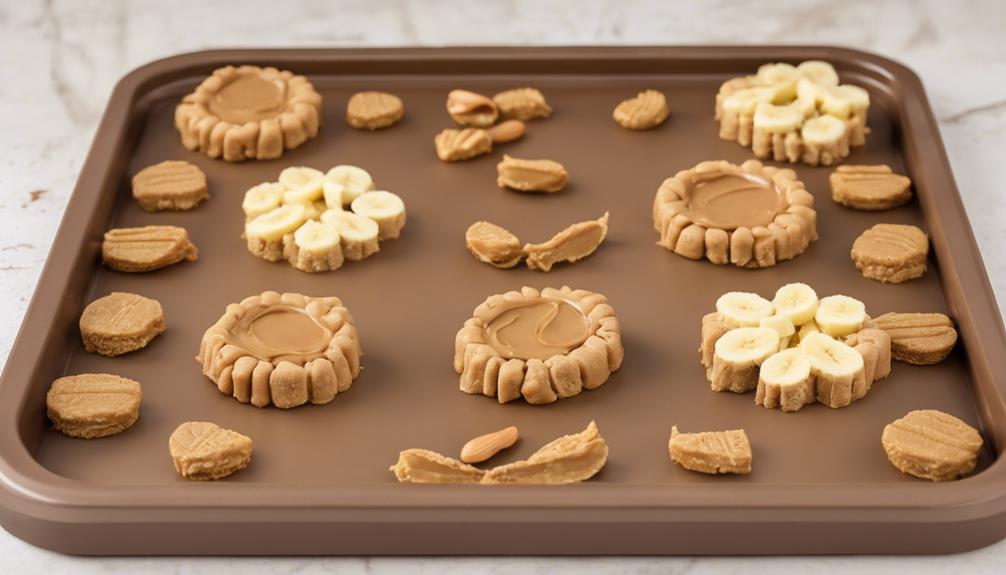
Indulge your furry friend with these irresistible Peanut Butter Delights that are simple to make and full of wholesome ingredients. Using a cup of peanut butter as the star ingredient, these homemade dog treats aren't only easy to make but also serve as a great source of positive reinforcement during training sessions.
Here's what you need to know:
- Key Ingredients: The Peanut Butter Delights recipe calls for a cup of peanut butter, oat flour, applesauce, and water/broth.
- Storage Tips: Homemade treats can be stored in the fridge for up to a week or frozen for 3 months to maintain freshness.
- Oat Flour Preparation: You can easily make oat flour at home by grinding rolled oats in a food processor for about 30 seconds.
- Healthy Option: Dogs can safely enjoy peanut butter treats without xylitol, providing a tasty and healthy snack for your furry companion.
Oat Flour Creations Recipe
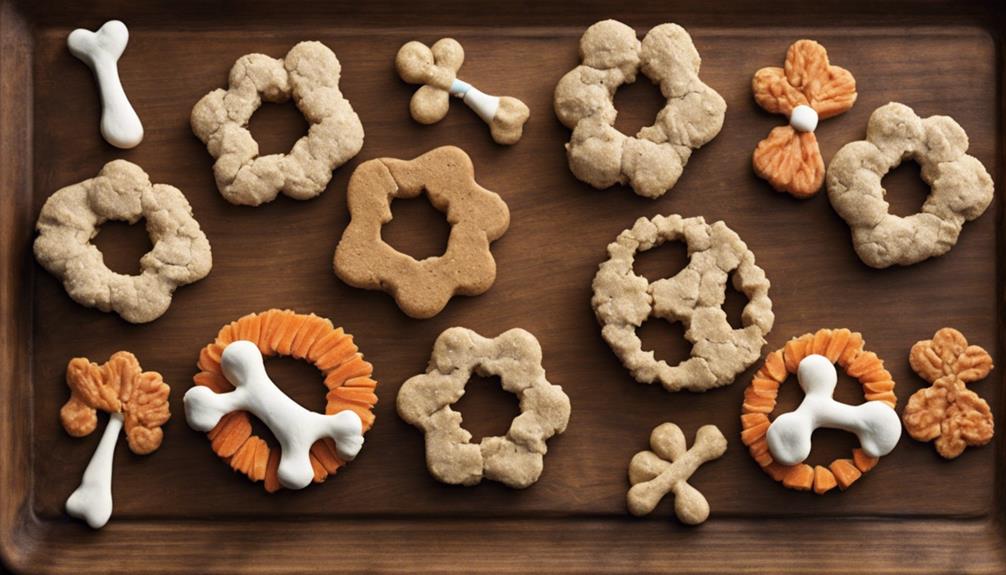
Discover the versatility of oat flour in creating nutritious and delicious homemade dog treats. Oat flour, made by grinding rolled oats in a food processor, is a healthy alternative to whole wheat flour in dog treat recipes. Dogs can safely consume oats in small quantities, benefiting from the added fiber.
Incorporating oat flour into your homemade dog treats not only enhances their nutritional value but also provides a unique texture that dogs love. Store your oat flour creations in the fridge or freezer to maintain their freshness for longer periods.
To make oat flour dog treats, combine oat flour with other dog-safe ingredients like peanut butter or pumpkin to create tasty variations. Experiment with different shapes and sizes using cookie cutters for added fun and engagement during training sessions. Remember to keep portions appropriate for your dog's size and dietary needs.
FAQ on Dog-Safe Ingredients
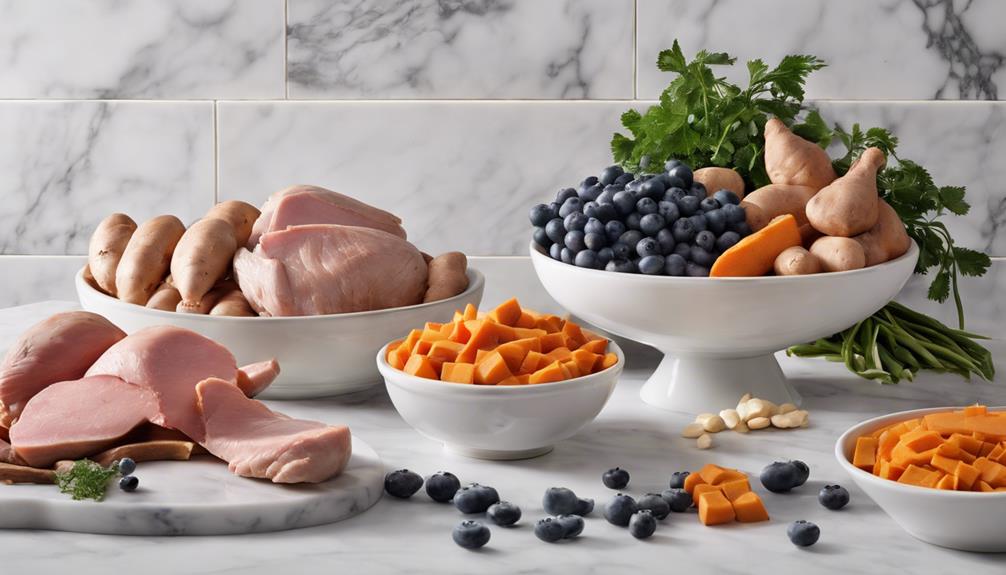
To ensure your dog's safety and health, acquaint yourself with common dog-safe ingredients used in homemade treats. When creating your own dog treats, prioritizing your furry friend's well-being is crucial. Here are some frequently asked questions about dog-safe ingredients:
- Peanut Butter: Opt for varieties that don't contain xylitol, a harmful substance for dogs.
- Oat Flour: This flour, made by grinding rolled oats, is a safe alternative to regular flour and can be easily prepared at home.
- Applesauce: Choose sugar-free applesauce to enhance flavor and moisture in your homemade treats.
- Water or Broth: These can be added to treat recipes to achieve the desired consistency and texture, ensuring your treats are palatable for your pup.
Furthermore, consider incorporating pumpkin purée into your recipes. This versatile ingredient not only adds nutrients but also provides a delicious flavor variation for your dog's enjoyment. By being mindful of these ingredients, you can create tasty and safe homemade treats for your canine companion.
Recommended Products for Treat Making
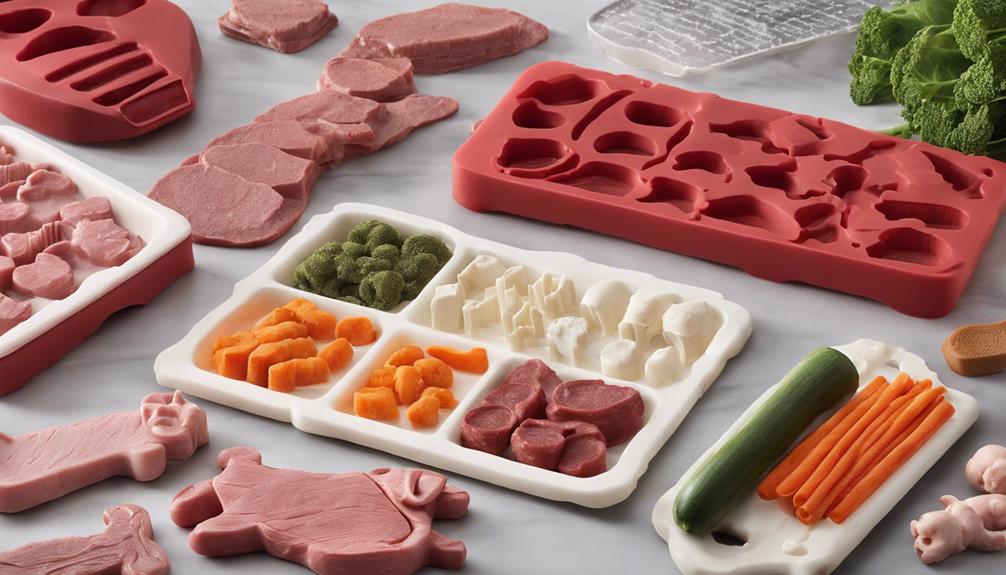
When considering tools and ingredients for making homemade dog treats, silicone pyramid mats and tapioca flour are recommended for accurate shaping and texture control. Silicone pyramid mats provide a structured surface for creating uniform treats, while tapioca flour helps achieve the ideal chewy consistency that dogs love. For the health-conscious pet owner, using whole wheat flour, eggs, pumpkin puree, and peanut butter can result in nutritious homemade dog treats that are free from additives and preservatives. Following specific recipes like 500 Homemade Dog Treats with Tuna or Apple Crumble ensures that your treats are not only delicious but also tailored to your dog's preferences. To maintain the freshness of your homemade dog treats, store them in an air-tight container to prevent them from becoming stale. By incorporating these recommended products and techniques into your treat-making process, you can guarantee that your furry friend receives the best quality snacks.
| Recommended Products | Benefits |
|---|---|
| Silicone Pyramid Mats | Accurate shaping |
| Tapioca Flour | Chewy texture control |
| Whole Wheat Flour | Nutritious ingredients |
| Specific Recipes | Delicious variations |
| Proper Storage | Freshness preservation |
Frequently Asked Questions
What Do Professional Dog Trainers Use for Treats?
Professional dog trainers use small, soft, and flavorful treats for training. These treats are low in calories to prevent overfeeding. Ingredients like meat, peanut butter, and pumpkin are common. Consistency and size are important for quick reinforcement.
How to Make High-Value Dog Training Treats?
To make high-value dog training treats, choose small, tasty, low-calorie options like homemade treats with salmon, sweet potato, or liver. Opt for soft textures for quick rewards, use silicone molds for consistency, and enjoy knowing the healthy ingredients you're giving your pup.
What to Avoid in Dog Training Treats?
When making dog training treats, avoid toxic foods like chocolate, corn on the cob, grapes, artificial sweeteners, and cooked bones. Opt for homemade treats to guarantee your furry friend's safety and well-being during training sessions.
How Do You Make Small Dog Training Treats?
To make small dog training treats, you'll need ingredients like meat, veggies, and flour. Mix, shape into bite-sized pieces, and bake until firm. Store in an airtight container. These treats will keep your pup engaged and motivated during training sessions.
What Are the Best Homemade Dog Training Treats to Use for Mastering Dog Training?
When it comes to mastering dog training, finding the best homemade dog training treats is essential. Look for simple recipes that use healthy ingredients like peanut butter and pumpkin. Using this dog training treats guide will ensure your furry friend is motivated and rewarded during training sessions.
Conclusion
To sum up, making homemade dog treats can be an enjoyable and fulfilling experience for both you and your furry companion. Remember to use dog-safe ingredients and follow appropriate storage guidelines to make certain the treats stay fresh and tasty.
With our ultimate dog training treats recipe guide, you'll be able to whip up delicious treats like Peanut Butter Delights and Oat Flour Creations in no time. Pamper your pup with these healthy and tasty snacks!
